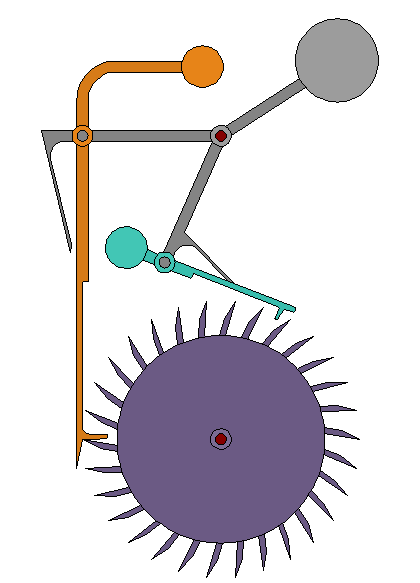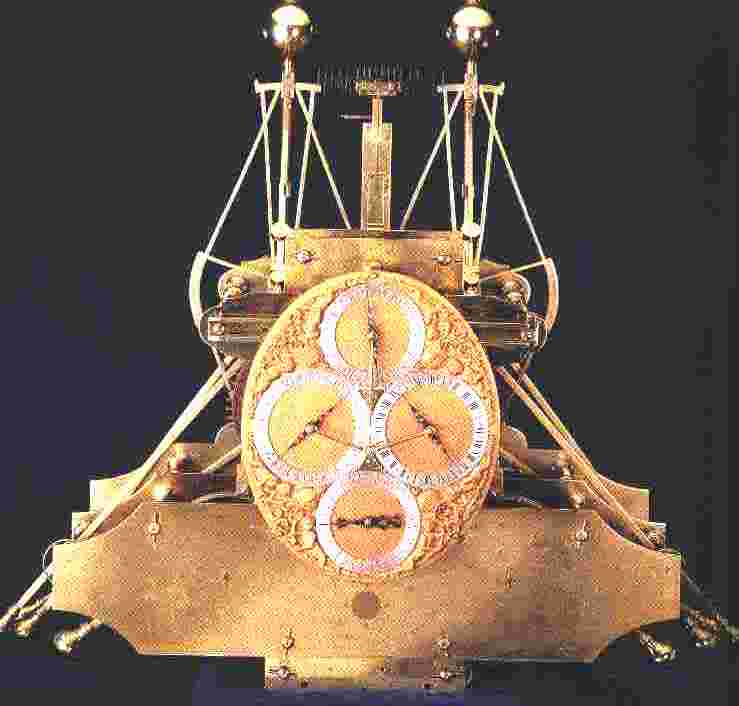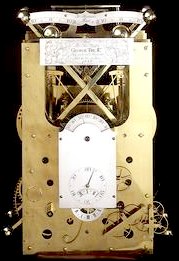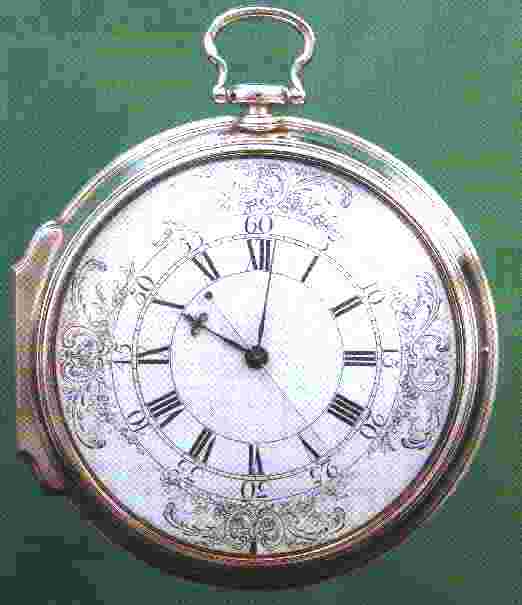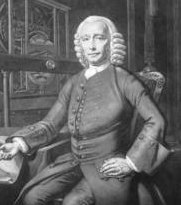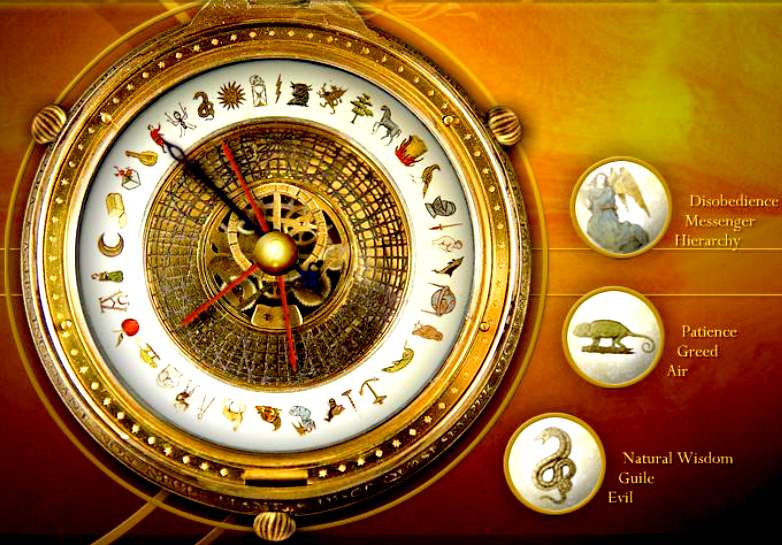|
JOHN HARRISON 1693 - 1776
|
|
|
In July of 1714, during the reign of Queen Anne, the Longitude Act was passed in response to the Merchants and Seamen petition presented to Westminster Palace in May of 1714. A prize of £20,000 was offered for a method of determining longitude to an accuracy of half a degree of a great circle. Half a degree being sixty nautical miles. This problem was tackled enthusiastically by learned astronomers, who were held in high regard by their contemporaries.
The longitude problem was eventually solved by a working class joiner from Lincolnshire with little formal education. John Harrison took on the scientific and academic establishment of his time and won the longitude prize through extraordinary mechanical adaptability, and sheer determination.
John Harrison was born March 24th 1693, in Yorkshire, moving to the village of Barrow upon Humber in Lincolnshire, son of a carpenter. John Harrison built his first pendulum clock before he was twenty. It was made almost entirely from wood. Around 1720 Sir Charles Pelham hired him to build a tower clock above stables at the manor house in Brocklesby Park. Completed in 1722 this clock still tells time in the Park, running continuously for 270 years except for refurbishment is 1884.
During the latter part of his early career, he worked with his younger brother James. Their first major project was a revolutionary turret clock for the stables at Brocklesby Park, seat of the Pelham family. The clock was revolutionary because it required no lubrication. 18th century clock oils were uniformly poor and one of the major causes of failure in clocks of the period. Rather than concentrating on improvements to the oil, Harrison designed a clock which didn't need it. It was radical thinking of this sort that would be important later on, when he tackled the problem of designing a marine timekeeper.
By 1727 Harrison turned his attention to the longitude prize. In 1730 Harrison arrived in London to find no offices for the Board of Longitude. Instead he approached Dr Edmond Halley, the astronomer royal, at the Royal Observatory at Greenwich. Halley sent Harrison to the well known watch maker, George Graham. Graham, a Fellow of the Royal Society, was so impressed by the thoughts of Harrison that he became his patron packing him off with a substantial loan. This allowed Harrison to spend the next five years making his first sea clock called simply Harrison No. or H1. This clock was put on board H.M.S. Centurion under the command of Captain Proctor ending up at Lisbon, Portugal, but never sailed to the West Indies as required by the Longitude Act.
Constructed between 1730 and 1735, H1 is essentially a portable version of Harrison's precision wooden clocks. It is spring-driven and only runs for one day (the wooden clocks run for eight days). The moving parts are controlled and counterbalanced by springs so that, unlike a pendulum clock, H1 is independent of the direction of gravity.
The H1
On June 24th 1737, Harrison presented the H1 to the Board of Longitude, convened for the very first time after its creation. Instead of demanding a sea trial, he asked for further a further £500 and two more years to refine his clock and reduce its size. The Board agreed paying half in advance, the balance to be paid when Harrison turned over the H2 for sea trials.
By the time he presented his second clock, the H2, to the Board Harrison was already unhappy with it. He requested of the commissioners more time and money to refine his concept. It took nineteen more years to to complete the H3, Harrison stopping only to request further injections of £500, five payments in all, to keep him going.
Larger and heavier than H1, H2 is of fundamentally the same design as H1. Harrison began work on H2 in 1737 but in 1740 realised its design was wrong. The bar balances did not always counter the motion of a ship, a deficiency that could be corrected if the balances were circular.
Inspired by a pocket watch made in 1753 by John Jefferys, for his own personal use John Harrison completed the H4 in 1759. This watch which runs for 30 hours on a single winding ultimately won him the longitude prize.
In 1753, Harrison commissioned London watchmaker John Jefferys to make him a watch following Harrison's own designs. The watch was intended for Harrison's own personal use - to help with his astronomical observing and clock testing. No one in the 1750s thought of the pocket watch as a serious timekeeper. However, Harrison discovered with his new watch that if certain improvements were made, it had the potential to be an excellent timekeeper.
H4 is completely different from the other three timekeepers. Just 13 cm in diameter and weighing 1.45 kg, it looks like a very large pocket watch. Harrison's son William set sail for the West Indies, with H4, aboard the ship Deptford on 18 November 1761. They arrived in Jamaica on 19 January 1762, where the watch was found to be only 5.1 seconds slow! It was a remarkable achievement but it would be some time before the Board of Longitude was sufficiently satisfied to award Harrison the prize.
The H2
William Harrison set out for Porstmouth in May of 1761 to wait for a ship with the H3 and H4. But no ship arrived. So William returned to London. Finally, in November he embarked on H.M.S. Deptford with H4 alone under Captain Dudley Digges. They arrived at Port Royal on January 19 1762 when the Board's representative John Robison and Harrison synchronised their watches to fix the longitude of Port Royal by the time difference between them, concluding H4 had lost only five seconds after 81 days at sea.
Although the performance of H4 during its second sea trial was three times better than the two minutes accuracy required to win the longitude prize, the Board of Longitude remained unconvinced. They stated that half of the prize money would be paid once Harrison had disclosed the workings of H4 to a specially-appointed committee. They also implied that H4's accuracy was a fluke and that copies of the watch should be made and tested. Finally, all four of Harrison's timekeepers should be handed over to the Board once he had received the £10,000. Harrison initially refused to accept any of these proposals, but the Board was equally stubborn. However, after several weeks contemplation, John and William finally agreed to disclose the inner workings of H4.
In August 1765, a panel of six experts gathered at Harrison's house in London and examined the watch. One week later, they were satisfied that the disclosure was complete and had signed a certificate to this effect. The Board then insisted that the four timekeepers should be handed over to them, and asked Harrison to recommend someone who could copy H4. Reluctantly, he recommended Larcum Kendall, a leading watchmaker who had probably contributed to the construction of H4, and finally received the first half of the longitude prize.
The H4
H5 was put on trial by the King himself in 1772, and performed superbly. The Board of Longitude, however, refused to recognise the results of this trial, so John and William petitioned Parliament. They were finally awarded £8750 by Act of Parliament in June 1773. Perhaps more importantly, John Harrison was finally recognised as having solved the longitude problem.
In the meantime, Captain Cook had set out on his second voyage of discovery with K1, Kendall's copy of H4. He returned in July 1775, after a voyage of three years, which ranged from the Tropics to the Antarctic. The daily rate of K1 never exceeded 8 seconds (corresponding to a distance of 2 nautical miles at the equator) during the entire voyage and Cook referred to the watch as: "Our faithful guide through all the vicissitudes of climates."
There followed a new Longitude Act in 1765 officially called Act 5 George III. It was only after the intervention of the King that Harrison finally received a £10,000 prize in the autumn of 1765.
MEMORIALS
Harrison died on his eighty-third birthday and is buried in the graveyard of St John's Church, Hampstead along with his second wife Elizabeth and their son William. His tomb was restored in 1879 by the Worshipful Company of Clockmakers even though Harrison had never been a member of the Company.
The H5
After
World War I, Harrison's timepieces were rediscovered at the Royal Greenwich Observatory by retired
naval officer Lieutenant Commander Rupert T. Gould. They were in a highly decrepit state, and Gould then spent many years documenting, repairing and restoring them without being compensated for his efforts. It was Gould, not Harrison, who gave them the designations H1 to H5, although initially he called them simply No.1 to No.5. Unfortunately Gould made some of his own modifications and repairs to these machines that would not pass today's standards of good museum conservation practice, although most Harrison scholars give Gould some credit for having ensured the survival of the historical artifacts as working mechanisms to the present time. Gould is the author of the book The Marine Chronometer, covering the history of chronometers from the Middle Ages through to the 1920s. It includes detailed descriptions of Harrison's work and the subsequent
evolution of the chronometer. It remains the authoritative work on the marine chronometer.
In 1995, following a major Symposium on the Longitude Problem organized by the National Association of Watch and Clock Collectors
(NAWCC) at Harvard
University, Dava Sobel wrote a book chronicling the history of John Harrison's invention entitled Longitude: The True Story of a Lone Genius Who Solved the Greatest Scientific Problem of His Time. Although horological historians are of the opinion that Sobel
over-dramatised events such as the struggle between Harrison and
Maskelyne, her book became the first ever popular bestseller with a theme focused on horology.
Without a compass the marine chronometer has little meaning. As with all human inventions and developments it takes a combination of progressions before real advances can be made. The compass shown above is not typical of the kind used by mariners to determine north, and hence steer a course. It is an alethiometer, a fictional device that tells the owner the truth.
LINKS
John Harrison and the Longitude Problem, at the National Maritime Museum site PBS Nova Online: Lost at Sea, the Search for Longitude John 'Longitude' Harrison and musical tuning UK Telegraph: 'Clock from 1776 just goes on and on' Andrew Johnson, Longitude pioneer was not a 'lone genius', The Independent, 31 May 2009 Excellent accounting of John Harrison and his H1,H2,H3 Achievements Harrison's precision pendulum-clock No. 2, 1727, on the BBC's "A History of the World" website The True Story of a Lone Genius Who Solved the Greatest Scientific Problem of His Time, January 17, 1999. What Were the UK Earnings and Prices Then? MeasuringWorth. Inflation: The value of the pound". House of Commons library 100 great British heroes, BBC, 21 August 2002 John Harrison: Timekeeper to Nostell and the world!, BBC Bradford and West Yorshire, 8 April 2009 The Genius of John Harrison revealed at Fairfax House : Antiques Information Services Federation of the Swiss Watch Industry Harrison's Marine timekeeper (H1) Harrison's Marine timekeeper (H2 Harrison's Marine timekeeper (H3) Harrison's Marine timekeeper (H4)
The Holy Compass is a John Storm adventure featuring the stunning Elizabeth Swan ship and all the crew from previous adventures
|
|
|
This website is Copyright © 1999 & 2019 Max Energy Limited, an environmental educational charity working hard for world peace. The names Solar Navigator™, Miss Ocean™ and Utopia Tristar™ are trademarks. All other trademarks are hereby acknowledged.
|
